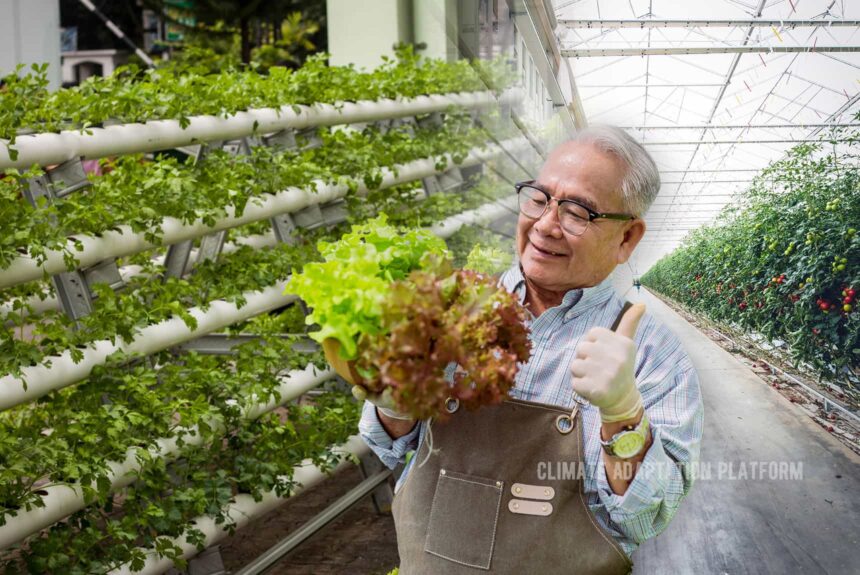Australia is a country regularly ravaged by wildfires, and more recently, repeated flood events have destroyed lives and livelihoods in several communities in the eastern states.
As for water availability, Australian farmers know this precious resource will continue to challenge the country’s food supply.
Food producers need innovative solutions to cope with the new and emerging challenges from the changing climate and increases in future demands and to make food production more sustainable.
One of these solutions for sustainable food production is vertical farming—crops and vegetable are grown indoors in vertically stacked layers in a controlled environment.
Vertical farms aim to increase the amount of food produced in a shorter time, using much smaller space than traditional farming, significantly less water and almost zero pesticides.
Vertical farms use LED lighting instead of sunlight and controlled growing and nutrition systems; hence seasonal food can be grown all year round.
Vertical farms are emerging around the world and are recipients of funding. So far, the largest is in Dubai, which can produce 900 tones of greens annually. Europe’s largest vertical farm is in Copenhagen by Danish start-up Nordic Harvest which can produce 1000 tonnes of food a year (Dubai has, 2022).
The highest concentration of vertical farms is in the USA. In Asia, vertical farms are found in Japan, China, Singapore, South Korea, Taiwan, and Thailand. It’s also present in European countries, Germany, France, the UK, and the Netherlands (Countries using, 2019).
Stacked Farm is Australia’s vertical farm that started in 2017. Their first warehouse looks like a scene from a sci-fi movie. Numerous rows of lettuce and other leafy vegetables are grown under artificial light.
Financial Review reports that Stacked is growing vegetables inside a 5,000 to 7,000 square meter facility, with the Australian vertical farm promising to process the largest output of leafy green produce per square meter of any vertical farm in the world. The company also claims that it uses 95% less water and processes three times faster than traditional farming.
Its chief executive Conrad Smith said the first facility would focus on green leafy vegetables, lettuce, and herbs. Still, the start-up is also investing in ways to grow strawberries, blueberries, grapes and other staples.
Its start-up is in Queensland, but it also looks to build more vertical farms in Victoria and NSW. The company claims it has already locked in contracts for 90% of its products with the country’s biggest fresh wholesaler with plans to produce around 70 tonnes of crops per week.
Vertical farms clearly have their advantages. They are less resource intensive because it requires a smaller area of land needed. It requires significantly less water, and crops face fewer risks of damage from extreme events and pests and shorter growing times.
However, starting a vertical farm requires a high start-up cost than traditional farming. Additionally, if the energy used to power vertical farms is from fossil fuels, they could emit more GHG than traditional farms.
Addressing this challenge and adapting to climate-friendly options make vertical farming a potential climate adaptation option in food production.
Source:
Redrup, Y. (2022, July 3). Lettuce for all: how vertical farming will plug supply chain shortages. Financial Review. Retrieved from https://www.afr.com/companies/agriculture/lettuce-for-all-how-vertical-farming-will-plug-supply-chain-shortages-20220701-p5ay8u
Chen, D. (2022, December 6). VIDEO: Vertical farming, protected cropping helping farmers adapt to climate change. ABC News. Retrieved from https://www.abc.net.au/news/2022-12-06/vertical-farming-protected-cropping-helping-farmers/101734488
Dubai has the ‘world’s largest’ vertical farm – is this the future of agriculture? (2022, May 13). World Economic Forum. Retrieved from https://www.weforum.org/agenda/2022/05/vertical-farming-future-of-agriculture
Countries Using Vertical Farming. (2019). Vertical Farming Planet. Retrieved from https://verticalfarmingplanet.com/countries-using-vertical-farming/



Leave a Reply